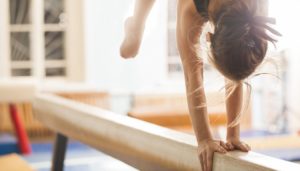The floor is a crucial part of your dance studio. As any dancer knows, the surface beneath your feet matters a great deal.
Most dance styles rely heavily on deft footwork. The dance studio flooring makes all that footwork possible by providing just the right support, comfort, grip, and feel. Flooring has a safety component too. Your choice of dance flooring can mean the difference between a perfect pirouette and a sprained ankle.
Whether you’re opening a new dance studio or remodeling an old one, flooring is a critical consideration. The same goes when dancing at home. Those laminated, tile, or stone floors might not be the best flooring for home dance studio.
This article is your guide to choosing the best flooring for a dance studio. Read on to learn about the top dance flooring options. We’ve also made a checklist of what to consider when laying and designing dance studio floors.
Related Article: 7 Tips for Owning a Successful Dance Studio
What Makes a Great Dance Studio Floor
What is the best flooring for a dance studio? That is the question.
Unfortunately, there’s no single answer. It all depends on what you really want from a dance studio floor. And that, in large part, comes down to what sort of dances will be taught or practiced in your studio. For example, tap dancers need a hard floor surface. That’s very different from the sprung floors necessary for acrobatic dance styles.
But let’s keep things simple for now. Here are the three main considerations you should make when choosing dance studio flooring.
Shock Absorption and Joint Protection
The dance studio floor should absorb shock fairly well. A shock-absorbent floor greatly reduces the impact and stress on the dancers’ joints, particularly around the ankles, knees, hips, and wrists. This minimizes the chances of acute and chronic injuries.
Up to 77% of dance injuries occur in the foot and ankle. These injuries result from repeated impact to the lower extremities, such as heavy landings on a single foot. A springy floor stands between your dancers and potential impact-related injuries like these.
Slip Resistance and Traction
A slippery floor is a danger to dancers. Well, depending on the dance they’re doing. For most dance styles, though, you need proper traction under your feet.
However, not so much grip that it feels like dancing on sandpaper. Just enough to prevent slipping while allowing the feet to glide effortlessly across the floor. Go for a dance floor material that strikes that delicate balance between slip and traction.
Durability and Maintenance
You, of course, want dance flooring that lasts long and is easy to look after. Dance studio floors take quite a battering through everyday use. More so in busy studios where dancers practice high-impact, fast-moving dances like salsa, hip hop, and tango.
Choose flooring that can take anything your dancers throw at it, be it piercing heel strikes, heavy stomping, or endless bangs from tap shoes.
But toughness is one thing, and maintenance is another. A dance studio floor should be easy and inexpensive to maintain. Think about what it takes to keep the floor clean, strong, and friendly to dancers.
Remember, a dance studio’s floor is a business investment, and not a light one either. Ensure that the investment earns returns for years and years.
Related Article: How to Improve Your Studio with Online Dance Software
Flooring Options and Their Trade-Offs
Let’s talk about the stuff that makes dance studio floors. There are many options when it comes to dance studio floor material. Here’s a breakdown of the more popular ones, highlighting their pros and cons.
Vinyl / Marley Rolls: The Industry Standard for Studios
If you’re a dancer yourself, you’ve probably seen, heard of, or danced on a marley floor. Marley floors are everywhere, favored for their simplicity and versatility.
Marley is a general term for performance roll-out vinyl flooring. This type of flooring is designed with just the right amount of grip and slip for most dance styles.
Originally, “Marley” was a brand name trademarked by an English company. The Marley Company pioneered vinyl dance floors that quickly caught on among professional dancers and performance stages. The company slowly disappeared in the ’80s, but the name “Marley” lived on as a generic term.
The Pros:
- Versatile: Suitable for just about any type of dance and dancer.
- Affordable: On average, marley rolls cost from $2 to $5 per square foot, depending on thickness and material.
- Easy installation: You only need tape and/or glue to stick marley mats to subflooring. Pretty easy to remove as well.
- Easy maintenance: As long as the flooring is properly installed, there’s not much in the way of maintenance, apart from sweeping and mopping.
- Slip–resistant: Marley dance floors are smooth yet sufficiently grippy.
- Portable: You can simply roll the marley floor out after a dance session.
The Cons:
- Low shock absorption: Standard marley floor rolls are only a few millimeters thick—not great for soaking impact.
- Subfloor dependent: Marley’s performance, durability, and safety as a dancing surface depend on the underlying subflooring.
Hardwood: For Performance and Longevity
Hardwood, such as maple and oak, is a popular flooring material for both residential and commercial spaces. You’ll find it in many homes and commercial dance studios too.
In 2024, hardwood was the third-best-selling hard surface flooring material in the US.
A sturdy, well-polished wooden surface gives your studio an almost nostalgic classic look. And the good thing is that it works for dance. Given the right finish, hardwood floors can accommodate a wide range of dance styles, from hip hop and tap to ballroom dancing.
The Pros:
- High durability: With proper care, a hardwood floor can last many decades. Even softwood floors can serve your dance studio for up to 30 years.
- Versatile: Hardwood floors can support various dance styles.
- Flexible: Different types of wood have different properties, allowing you to give the dancers exactly the kind of floor they want.
- Aesthetic liberty: A hardwood floor can be any color, texture, or finish you like.
The Cons:
- Costly: A typical hardwood floor costs about $6 to $12 per square foot.
- Involved maintenance: It takes skills and a whole lot of polish to take care of scratches, crowning, and cupping.
Modular / Portable Tiles / Panels: Endless Flexibility for Multi-Use Spaces
Did you know that dance studio flooring doesn’t have to be permanent?
That’s right, you can have removable modular flooring surfaces. These are great for sectioning your dance studio for multiple activities or dance sessions. Removable flooring also means the space can be used for other things besides dancing.
Modular dance floors come in the form of portable tiles, mats, or panels. The individual pieces either interlock together or stick to the subflooring using special adhesives.
The Pros:
- High flexibility: Portable/modular flooring opens your dance studio to more possibilities.
- Easy to maintain: Removable flooring requires minimal maintenance or none at all.
- Affordable: These are relatively inexpensive.
- Quick and easy installation: You can lay and remove modular floors literally in minutes—no special tools or skills needed.
- Storage ready: Like we saw with marley floors, these types of flooring materials can easily be rolled, stacked, or piled away for storage.
The Cons:
- Short lifespan: Some modular flooring materials are not very tough. They can wear out rather quickly, especially after repeated use cycles.
- Limited functionality: These types of dance floors come in specific sizes, dimensions, and builds, limiting how and where you can use them.
Composite or Vinyl Composite Tiles (VCT) and Other Alternatives
VCTs are a type of vinyl flooring—another favorite among dance studio owners. These tiles are made from a blend of multiple materials, including vinyl chips, limestone, and binding polymers. The result is a tough flooring material ideal for high-traffic areas, like a dance studio.
Other composite flooring options incorporate materials like wood, fiberglass, rubber, and fabric. They work great too as tough dance studio floors.
The Pros:
- Affordable: Composites are some of the least costly dance flooring materials.
- Wide range of options: You can play around with various material properties (thickness, composition, quality, etc.) to get your ideal dance floor.
- Easy to install: Installation generally involves sticking or overlaying the tiles on the subfloor.
- Great for dancing: The texture and feel of most composite tiles, particularly VCT, go well with most dance styles and footwear.
- Durable: Composites can see your studio floor through years of brutal punishment.
The Cons:
- Difficult maintenance: It can be tricky to keep some composite floor tiles clean and scratch-free.
- Subflooring dependent: The tiles’ performance as dance flooring relies heavily on the subfloor.
Related Article: How to Effectively Manage Dance Studio Staff
Choosing for Style, Budget, and Usage
The best flooring for your dance studio will generally depend on the studio’s purpose and your own preferences. Here are a few more things to keep in mind when choosing dance studio flooring.
Multi-Style Dance Studio Needs
For a multi-style studio, you may need multiple flooring layouts. Different dance styles require different floor surfaces. You could have a sprung floor for contemporary dances, a marley section for the hip hop crew, and a hardwood platform for tap dancing.
The idea here is to make every dancer feel at home.
Home vs. Commercial Studio Differences
What’s the difference between home and commercial dance studio floors? The answer is scale and toughness.
Commercial dance studios are larger and get more foot traffic. So, the floor must be built to withstand daily pounding from dozens of dancers. Since there’s more floor, it also needs to be easy to clean and maintain.
On the other hand, a home studio floor can be anything you want. You’re not really limited by scale or durability.
Budget Ranges and Cost Per Square Foot
How much are you willing to spend on dance studio flooring?
Cost is a critical factor when choosing dance flooring materials, designs, and layouts. Your flooring budget can very well determine what sort of dance floor you end up with.
As an entrepreneur, approach the budget issue from an investment perspective. Justify the cost with the potential returns.
Maintenance, Lifespan, and Replacement Cycles
Some flooring materials last longer than others. Quality hardwood, for example, can last well over 50 years. Meanwhile, vinyl will give you 10-20 years before it gives in to the dancers’ feet.
Consider the floor’s durability. Check how often you’ll have to replace the flooring throughout the studio’s operation. Also, understand what it will take to keep the floor fit for dancing.
Visual Design
Visuals matter in a dance studio. And it’s not just for aesthetics.
The floor color, for instance, can set the mood for your dance studio. Reds and oranges create an energetic atmosphere ideal for intense dance routines. Muted colors like blues and greens exude serenity—the perfect atmosphere for some contemporary dances.
The flooring can also have helpful visual cues for the dancers. Lines, stripes, or color changes can mark dancing zones.
FAQs
What is the best flooring for dance studio genres (ballet, hip hop, tap, acro)?
Cushioned sprung floor is the gold standard for ballet, modern, and pointe dance styles. Hardwood is ideal for tap, jazz, and ballroom dances. For most other dances, including hip hop and acro, you can’t go wrong with marley or vinyl.
Can I retrofit over concrete or gym floor?
Yes, you can.
Dance studio flooring like marley, vinyl composite tiles, and hardwood can be overlaid on stone and concrete floors.
How often should dance flooring be replaced?
That depends on the flooring material and how busy the studio is.
But generally, vinyl dance floors last 10-25 years, quality hardwood 50+ years, and composites need replacing every 15-20 years.
Is portable flooring “good enough” for a permanent studio?
Yes, portable dance flooring can be just as good (if not better) as permanent flooring.


